Introduction
Prebiotic-rich foods are gaining widespread recognition for their ability to improve digestion and support overall gut health. Unlike probiotics, which introduce live bacteria into your gut, prebiotics act as food for the beneficial bacteria already present. By incorporating prebiotic-rich foods into your diet, you can nourish your gut microbiome and enjoy better digestion, enhanced immunity, and improved mental health.
In this article, we’ll dive into the science behind prebiotics, explore the best prebiotic-rich foods, and share tips on how to seamlessly integrate them into your meals.
What Are Prebiotics?
Prebiotics are basically like the snack food for those friendly little critters in your belly called good bacteria. They’re a part of the fiber family that you eat, and they help keep your gut bacteria happy and well-fed. These fibers are not digested in the stomach or small intestine but reach the colon, where they are fermented by gut microbes.
Prebiotics play a vital role in maintaining a balanced gut microbiome, which affects digestion, metabolism, and immune function. Some of the most common types of prebiotic fibers include:
- Inulin
- Fructooligosaccharides (FOS)
- Galactooligosaccharides (GOS)
- Resistant starch
The Benefits of Prebiotic-Rich Foods
Including prebiotic-rich foods in your diet can significantly improve your gut health and overall well-being.
1. Improved Digestion
Prebiotics enhance the growth of beneficial bacteria like Bifidobacteria and Lactobacilli, which aid in breaking down food and absorbing nutrients. They also reduce bloating, constipation, and other digestive discomforts.
Read More: The Rise of Adaptogens: How Ashwagandha and Rhodiola Reduce Stress Naturally
2. Boosted Immunity
Around 70% of the immune system resides in the gut. Prebiotic-rich foods help maintain a healthy balance of gut bacteria, which strengthens the immune response and reduces inflammation.
3. Enhanced Mental Health
The gut-brain axis connects your digestive system to your brain. Prebiotics support the production of neurotransmitters like serotonin, which improves mood and reduces anxiety.
4. Better Weight Management
Prebiotics help regulate appetite by increasing the production of hormones that signal fullness. They also reduce fat storage and improve insulin sensitivity.
5. Reduced Risk of Chronic Diseases
A healthy gut microbiome, fueled by prebiotics, lowers the risk of chronic conditions like heart disease, diabetes, and obesity.
Top Prebiotic-Rich Foods
Adding prebiotic-rich foods to your diet is simple and delicious. Here are some of the best options:
1. Garlic
Garlic contains inulin and FOS, which promote the growth of beneficial gut bacteria. It also has antibacterial and anti-inflammatory properties.
How to Use: Add minced garlic to soups, stir-fries, and salad dressings.
2. Onions
Onions are rich in inulin and FOS, making them a great choice for gut health. They also contain antioxidants that reduce inflammation.
How to Use: Include onions in your stews, curries, or as a caramelized topping for dishes.
3. Bananas
Unripe bananas are a fantastic source of resistant starch, a prebiotic fiber that feeds good bacteria and regulates digestion.
How to Use: Add slices of green bananas to smoothies or oatmeal.
4. Asparagus
Asparagus is packed with inulin, which helps promote a healthy gut microbiome and improves digestion.
How to Use: Roast asparagus with olive oil and garlic for a flavorful side dish.
5. Chicory Root
Chicory root is one of the richest sources of inulin. It’s often used as a caffeine-free coffee substitute.
How to Use: Brew chicory root as a tea or mix it with coffee for a gut-friendly beverage.
6. Jerusalem Artichokes
Also known as sunchokes, these tubers are loaded with inulin and have a nutty, sweet flavor.
How to Use: Roast them or add them to salads for a crunchy texture.
7. Whole Grains
Oats, barley, and wheat contain resistant starch and beta-glucan, which nourish gut bacteria.
How to Use: Opt for whole-grain bread, oatmeal, or barley soup.
8. Apples
Apples are high in pectin, a type of soluble fiber that acts as a prebiotic and improves gut health.
How to Use: Snack on apples with nut butter or bake them with cinnamon for a healthy dessert.
How to Incorporate Prebiotic-Rich Foods into Your Diet
Boosting your intake of prebiotic-rich foods doesn’t have to be complicated. Here are some practical tips:
- Start Your Day Right: Add bananas or oats to your breakfast for a gut-friendly start.
- Snack Smart: Keep apple slices or roasted chickpeas on hand for a nutritious snack.
- Upgrade Your Sides: Include roasted asparagus or sautéed garlic in your meals.
- Try New Recipes: Experiment with chicory root tea or Jerusalem artichoke-based dishes.
- Combine with Probiotics: Pair prebiotics with probiotic-rich foods like yogurt or kimchi to maximize gut health benefits.
The Science Behind Prebiotic-Rich Foods
Research supports the positive effects of prebiotic-rich foods on gut health. A 2019 study published in Nutrients found that inulin supplementation significantly increased beneficial gut bacteria and improved digestion.
Another study in Frontiers in Immunology highlighted the role of prebiotics in enhancing the immune system and reducing inflammation. These findings confirm that prebiotics are an essential component of a balanced diet.
Meta Description:
Discover the top prebiotic-rich foods and their powerful benefits for gut health. Learn how to improve digestion, boost immunity, and support overall well-being naturally.
Conclusion
Prebiotic-rich foods are a cornerstone of gut health, offering numerous benefits that extend beyond digestion. By feeding the good bacteria in your gut, these foods improve immunity, mental health, and overall well-being. Whether you’re snacking on apples, adding garlic to your meals, or sipping on chicory root tea, there are endless ways to incorporate prebiotics into your daily routine.
Take the first step toward better health by embracing prebiotic-rich foods and giving your gut the nourishment it needs to thrive. Your body—and your gut—will thank you!

